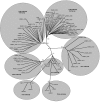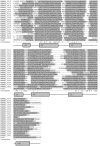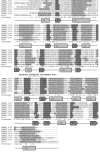GntR family of regulators in Mycobacterium smegmatis: a sequence and structure based characterization
- PMID: 17714599
- PMCID: PMC2018728
- DOI: 10.1186/1471-2164-8-289
GntR family of regulators in Mycobacterium smegmatis: a sequence and structure based characterization
Abstract
Background: Mycobacterium smegmatis is fast growing non-pathogenic mycobacteria. This organism has been widely used as a model organism to study the biology of other virulent and extremely slow growing species like Mycobacterium tuberculosis. Based on the homology of the N-terminal DNA binding domain, the recently sequenced genome of M. smegmatis has been shown to possess several putative GntR regulators. A striking characteristic feature of this family of regulators is that they possess a conserved N-terminal DNA binding domain and a diverse C-terminal domain involved in the effector binding and/or oligomerization. Since the physiological role of these regulators is critically dependent upon effector binding and operator sites, we have analysed and classified these regulators into their specific subfamilies and identified their potential binding sites.
Results: The sequence analysis of M. smegmatis putative GntRs has revealed that FadR, HutC, MocR and the YtrA-like regulators are encoded by 45, 8, 8 and 1 genes respectively. Further out of 45 FadR-like regulators, 19 were classified into the FadR group and 26 into the VanR group. All these proteins showed similar secondary structural elements specific to their respective subfamilies except MSMEG_3959, which showed additional secondary structural elements. Using the reciprocal BLAST searches, we further identified the orthologs of these regulators in Bacillus subtilis and other mycobacteria. Since the expression of many regulators is auto-regulatory, we have identified potential operator sites for a number of these GntR regulators by analyzing the upstream sequences.
Conclusion: This study helps in extending the annotation of M. smegmatis GntR proteins. It identifies the GntR regulators of M. smegmatis that could serve as a model for studying orthologous regulators from virulent as well as other saprophytic mycobacteria. This study also sheds some light on the nucleotide preferences in the target-motifs of GntRs thus providing important leads for initiating the experimental characterization of these proteins, construction of the gene regulatory network for these regulators and an understanding of the influence of these proteins on the physiology of the mycobacteria.
Figures






Similar articles
-
In silico analysis and characterization of GntR family of regulators from Mycobacterium tuberculosis.Tuberculosis (Edinb). 2007 May;87(3):242-7. doi: 10.1016/j.tube.2006.11.002. Epub 2006 Dec 27. Tuberculosis (Edinb). 2007. PMID: 17194626
-
GntR family regulators of the pathogen of fish tuberculosis Mycobacterium marinum.Biochem Biophys Res Commun. 2011 Jul 15;410(4):780-5. doi: 10.1016/j.bbrc.2011.06.059. Epub 2011 Jun 14. Biochem Biophys Res Commun. 2011. PMID: 21703231
-
GntR Family of Bacterial Transcription Factors and Their DNA Binding Motifs: Structure, Positioning and Co-Evolution.PLoS One. 2015 Jul 7;10(7):e0132618. doi: 10.1371/journal.pone.0132618. eCollection 2015. PLoS One. 2015. PMID: 26151451 Free PMC article.
-
Members of the IclR family of bacterial transcriptional regulators function as activators and/or repressors.FEMS Microbiol Rev. 2006 Mar;30(2):157-86. doi: 10.1111/j.1574-6976.2005.00008.x. FEMS Microbiol Rev. 2006. PMID: 16472303 Review.
-
Allosteric control of transcription in GntR family of transcription regulators: A structural overview.IUBMB Life. 2015 Jul;67(7):556-63. doi: 10.1002/iub.1401. Epub 2015 Jul 14. IUBMB Life. 2015. PMID: 26172911 Review.
Cited by
-
Using comparative genomics to uncover new kinds of protein-based metabolic organelles in bacteria.Protein Sci. 2013 Feb;22(2):179-95. doi: 10.1002/pro.2196. Epub 2013 Jan 4. Protein Sci. 2013. PMID: 23188745 Free PMC article.
-
Mycobacterium smegmatis RoxY is a repressor of oxyS and contributes to resistance to oxidative stress and bactericidal ubiquitin-derived peptides.J Bacteriol. 2011 Dec;193(24):6824-33. doi: 10.1128/JB.05492-11. Epub 2011 Oct 7. J Bacteriol. 2011. PMID: 21984791 Free PMC article.
-
RNA sequencing reveals differences between the global transcriptomes of Salmonella enterica serovar enteritidis strains with high and low pathogenicities.Appl Environ Microbiol. 2014 Feb;80(3):896-906. doi: 10.1128/AEM.02740-13. Epub 2013 Nov 22. Appl Environ Microbiol. 2014. PMID: 24271167 Free PMC article.
-
Genome bias influences amino acid choices: analysis of amino acid substitution and re-compilation of substitution matrices exclusive to an AT-biased genome.Nucleic Acids Res. 2008 Dec;36(21):6664-75. doi: 10.1093/nar/gkn635. Epub 2008 Oct 23. Nucleic Acids Res. 2008. PMID: 18948281 Free PMC article.
-
Rv2231c, a unique histidinol phosphate aminotransferase from Mycobacterium tuberculosis, supports virulence by inhibiting host-directed defense.Cell Mol Life Sci. 2024 May 2;81(1):203. doi: 10.1007/s00018-024-05200-8. Cell Mol Life Sci. 2024. PMID: 38698289 Free PMC article.
References
-
- Marchler-Bauer A, Anderson JB, Cherukuri PF, DeWeese-Scott C, Geer LY, Gwadz M, He S, Hurwitz DI, Jackson JD, Ke Z, Lanczycki CJ, Liebert CA, Liu C, Lu F, Marchler GH, Mullokandov M, Shoemaker BA, Simonyan V, Song JS, Thiessen PA, Yamashita RA, Yin JJ, Zhang D, Bryant SH. CDD: a Conserved Domain Database for protein classification. Nucleic Acids Res. 2005;33:D192–196. doi: 10.1093/nar/gki069. - DOI - PMC - PubMed
-
- Rigali S, Schlicht M, Hoskisson P, Nothaft H, Merzbacher M, Joris B, Titgemeyer F. Extending the classification of bacterial transcription factors beyond the helix-turn-helix motif as an alternative approach to discover new cis/trans relationships. Nucleic Acids Res. 2004;32:3418–3426. doi: 10.1093/nar/gkh673. - DOI - PMC - PubMed
Publication types
MeSH terms
Substances
LinkOut - more resources
Full Text Sources
Research Materials

